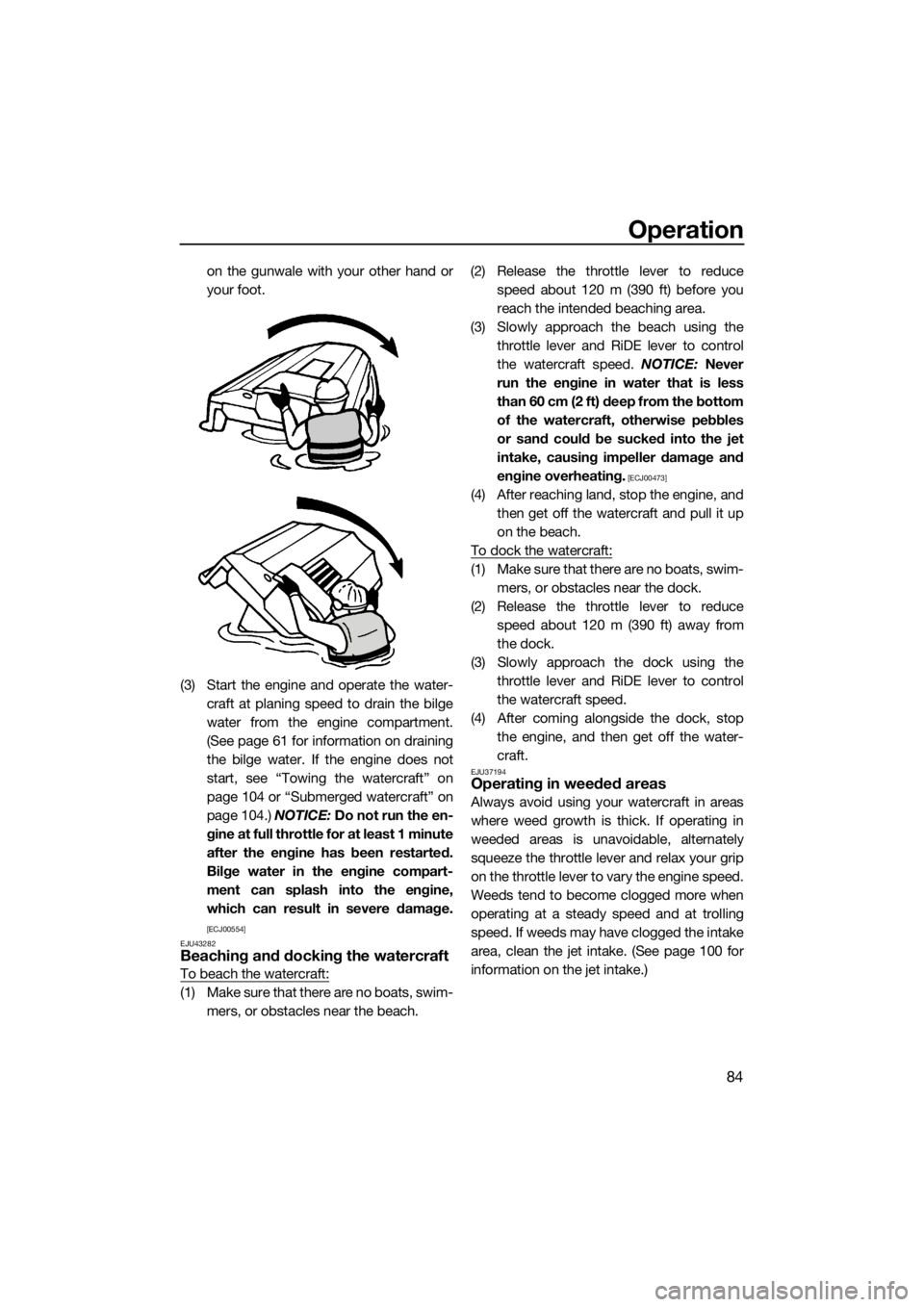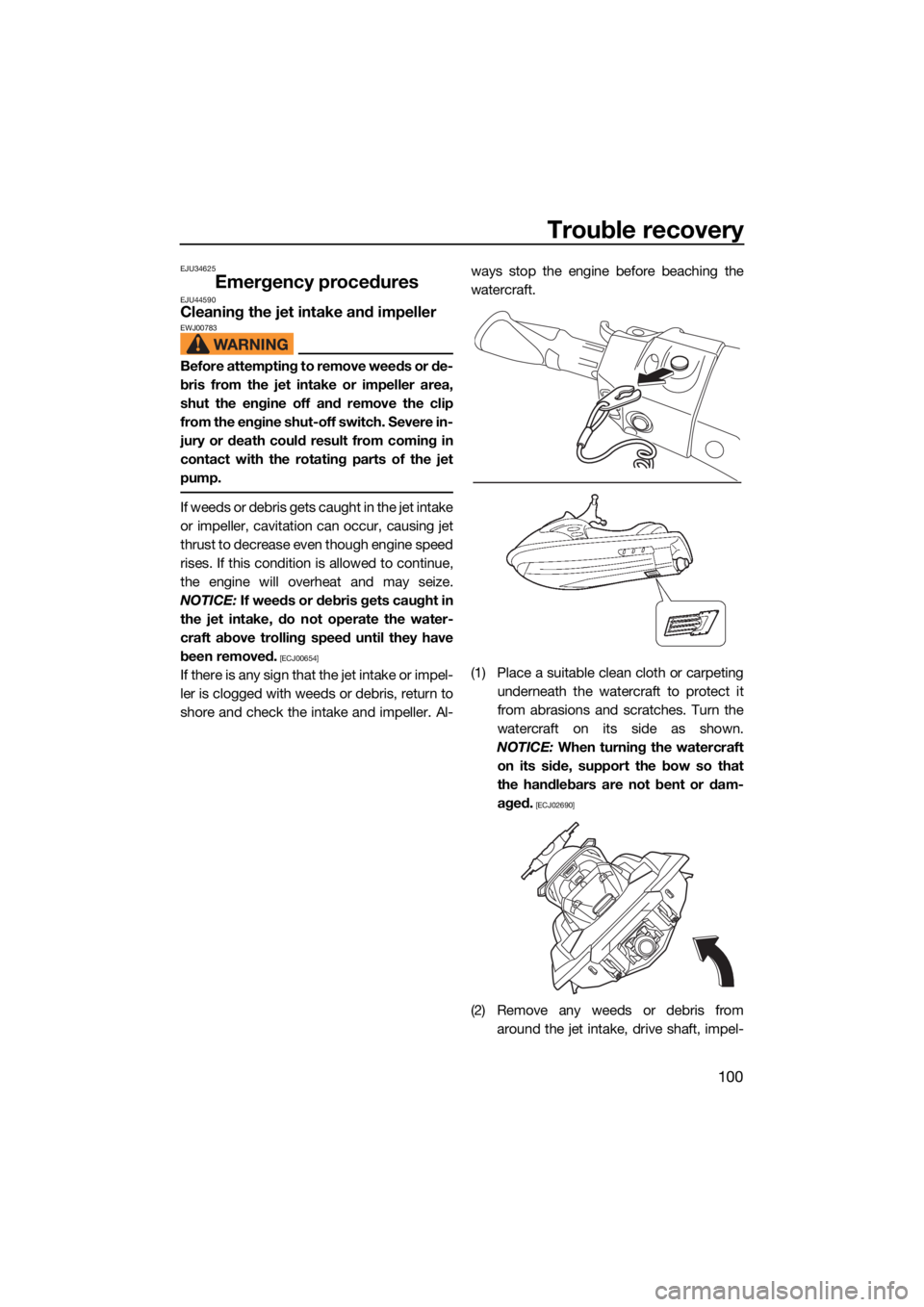Page 91 of 116

Operation
84
on the gunwale with your other hand or
your foot.
(3) Start the engine and operate the water- craft at planing speed to drain the bilge
water from the engine compartment.
(See page 61 for information on draining
the bilge water. If the engine does not
start, see “Towing the watercraft” on
page 104 or “Submerged watercraft” on
page 104.) NOTICE: Do not run the en-
gine at full throttle for at least 1 minute
after the engine has been restarted.
Bilge water in the engine compart-
ment can splash into the engine,
which can result in severe damage.
[ECJ00554]
EJU43282
Beaching and docking the watercraft
To beach the watercraft:
(1) Make sure that there are no boats, swim- mers, or obstacles near the beach. (2) Release the throttle lever to reduce
speed about 120 m (390 ft) before you
reach the intended beaching area.
(3) Slowly approach the beach using the throttle lever and RiDE lever to control
the watercraft speed. NOTICE: Never
run the engine in water that is less
than 60 cm (2 ft) deep from the bottom
of the watercraft, otherwise pebbles
or sand could be sucked into the jet
intake, causing impeller damage and
engine overheating.
[ECJ00473]
(4) After reaching land, stop the engine, and then get off the watercraft and pull it up
on the beach.
To dock the watercraft:
(1) Make sure that there are no boats, swim- mers, or obstacles near the dock.
(2) Release the throttle lever to reduce speed about 120 m (390 ft) away from
the dock.
(3) Slowly approach the dock using the throttle lever and RiDE lever to control
the watercraft speed.
(4) After coming alongside the dock, stop the engine, and then get off the water-
craft.
EJU37194Operating in weeded areas
Always avoid using your watercraft in areas
where weed growth is thick. If operating in
weeded areas is unavoidable, alternately
squeeze the throttle lever and relax your grip
on the throttle lever to vary the engine speed.
Weeds tend to become clogged more when
operating at a steady speed and at trolling
speed. If weeds may have clogged the intake
area, clean the jet intake. (See page 100 for
information on the jet intake.)
UF3X72E0.book Page 84 Friday, May 29, 2020 10:09 AM
Page 92 of 116
Operation
85
EJU40242After removing the watercraft from
the water
ECJ01311
Do not run the engine over 4000 r/min on
land. Also, do not run the engine for more
than 15 seconds without supplying water,
otherwise the engine could overheat.
After operating and removing the watercraft
from the water, promptly discharge the re-
maining water from the cooling water pas-
sages.
To discharge water from the cooling water
passages:
(1) Make sure that the area around the wa- tercraft is clear, and then start the en-
gine.
(2) Discharge the remaining water out of the cooling water passages by alternately
squeezing and releasing the throttle lever
quickly for 10 to 15 seconds.
(3) Stop the engine.
UF3X72E0.book Page 85 Friday, May 29, 2020 10:09 AM
Page 107 of 116

Trouble recovery
100
EJU34625
Emergency proceduresEJU44590Cleaning the jet intake and impellerEWJ00783
Before attempting to remove weeds or de-
bris from the jet intake or impeller area,
shut the engine off and remove the clip
from the engine shut-off switch. Severe in-
jury or death could result from coming in
contact with the rotating parts of the jet
pump.
If weeds or debris gets caught in the jet intake
or impeller, cavitation can occur, causing jet
thrust to decrease even though engine speed
rises. If this condition is allowed to continue,
the engine will overheat and may seize.
NOTICE: If weeds or debris gets caught in
the jet intake, do not operate the water-
craft above trolling speed until they have
been removed.
[ECJ00654]
If there is any sign that the jet intake or impel-
ler is clogged with weeds or debris, return to
shore and check the intake and impeller. Al- ways stop the engine before beaching the
watercraft.
(1) Place a suitable clean cloth or carpeting
underneath the watercraft to protect it
from abrasions and scratches. Turn the
watercraft on its side as shown.
NOTICE: When turning the watercraft
on its side, support the bow so that
the handlebars are not bent or dam-
aged.
[ECJ02690]
(2) Remove any weeds or debris from around the jet intake, drive shaft, impel-
UF3X72E0.book Page 100 Friday, May 29, 2020 10:09 AM